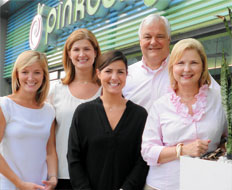New Orleans native Rob Stumm, along with his daughters Courtney and Celie, became a Pinkberry Frozen Yogurt franchisee in 2008 and now owns three units, with the fourth on the way. It’s the second unit the Stumms opened, though, that is the real star of their business.
The family successfully transformed a run-down corner of New Orleans into the jewel of the Pinkberry system. Stumm, a licensed architect, discovered an odd-shaped lot with a gazebo near the French Quarter that was used by employees of the neighboring hotel for smoke breaks. With the help of his daughters, and using some of his architectural creativity, Stumm built out the location as a Pinkberry unit and has since turned it into one of the company’s best-performing locations.
The Stumms explain how you can transform a less-than-ideal location into a profitable quick-serve unit.
1. Map out your vision
One unique thing that Pinkberry had us do in the screening process was to make a presentation on the “how” and “why” of franchising for them. This made the three of us sit down and map out the vision we had for the brand and the concept. It turned out to be an integral part of our success because many franchisees will focus in on the location first, or how to save the most money initially. Those are vital, but having that concise plan to follow that we developed more than three years ago and executing it today has attributed most to our success.
This sort of planning before you pick the spot is crucial to the overall vision of the brand and where you want to go as a business owner.
2. Don’t be afraid to move the bank
It was important for us to launch the brand in the center of New Orleans. In order to get our first store, we had to buy the entire building, but the location was more than ideal. With a Whole Foods and other stores right across the street, we knew that our customers would be there.
We knew that our second location needed to yield the same results, if we were going to continue with growth. The site of our second store, before we came in, was not what you would consider ideal in terms of surroundings, but the location again was where we wanted to be. Our biggest edge is having this sort of iconic real estate, while not being afraid to move the bank.
We had a proper moneymaking unit in our first location and were not fearful of transferring that somewhere else. Just because another location might not look ideal doesn’t mean that you should be prepared to make less with it. With this new location for our second unit, we were able to reach the community with just a stretch of our arm because they were right in front of us.
3. Don’t compromise on location
We knew our target market going into our second location, and brought the concept to them, not the other way around. Franchisees should never compromise on real estate. We didn’t want to settle on a location that might be easier to set up but is farther away from our market.
With this location, the community can see very clearly our commitment to providing a good product and keeping it within the realm of their locale. We were bringing something innovative as a product, but built the second unit in such a way that it’s an additional draw as a fun, open place to hang out.
Our unique and iconic real estate decisions have even brought other Pinkberry developers to us asking whether or not a location they had in mind is a good spot for Pinkberry. They’ve acknowledged our design principles and are seeing it work in areas that they might not have considered initially.
Franchisees need to fit the concept for the location. You can’t just bring in any concept into a good location and expect positive results. It just doesn’t work that way anymore. We found the product, then found the unique real estate to fit.
4. Be financially responsible, but not cheap
A lot of franchisees have the mindset of, “How cheap can I get in for?” When it comes to being in a good location and providing the product, this mentality isn’t going to cut it. Our second location, even though the surroundings weren’t as attractive as other units, was our most costly build out. It wasn’t a money-saving opportunity for us because of the environment.
Don’t compromise and don’t look for the cheapest way to do it. Find the location you want first and then get tough with finding the most cost-effective option. Additionally, you need to have a reserve set-up financially when starting any new location, even if it’s in the most suitable area. Until you understand the fiscal history for each outlet, be prepared for financial shortcomings.
A good way to prevent any losses is to get out and create the talk for your brand. Be the face of your product and spread your influence to the surrounding businesses or community. Marketing will more than likely be the most concentrated business practice when you’re first starting out in a new location.







